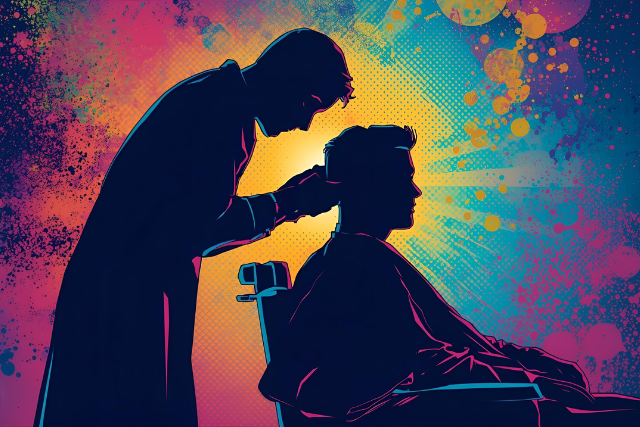“We don’t inherit the earth from our ancestors; we borrow it from our children.” ~Native American Proverb
For years, I blamed my parents for my anxiety, my defensiveness, and my need to be right. Then I learned they inherited the same patterns from their parents. And theirs before them.
This wasn’t about blame. It was about breaking a cycle nobody chose.
The Stutter That Taught Me Everything
As a teenager, I developed a stutter. Not just occasional hesitation—paralyzing anxiety about speaking.
I’d anticipate making mistakes when reading aloud. Starting conversations felt like walking through a minefield. The fear of stuttering …
“We don’t inherit the earth from our ancestors; we borrow it from our children.” ~Native American Proverb
For years, I blamed my parents for my anxiety, my defensiveness, and my need to be right. Then I learned they inherited the same patterns from their parents. And theirs before them.
This wasn’t about blame. It was about breaking a cycle nobody chose.
The Stutter That Taught Me Everything
As a teenager, I developed a stutter. Not just occasional hesitation—paralyzing anxiety about speaking.
I’d anticipate making mistakes when reading aloud. Starting conversations felt like walking through a minefield. The fear of stuttering made me stutter more—a cruel self-fulfilling prophecy.
In college, studying psychology, I discovered something liberating. The anxiety about stuttering was causing the stuttering.
Once I learned to relax, breathe deeply, and stop anticipating errors, the stutter disappeared. Years later, I successfully presented high-stakes business proposals to executives. Not a single stumble.
I thought I’d conquered a personal flaw through willpower and technique. I was wrong.
The Discovery That Changed Everything
During college, I learned my father’s story. As a child, he had a lisp.
His father—my grandfather—thought it was hilarious. He’d make my dad recite tongue-twisters in front of family and friends. Highlighting his speech impediment for entertainment.
That cruel mockery created anxiety. That anxiety transmitted to me.
Different manifestation—stuttering instead of a lisp. Same underlying pattern: fear of speaking, anticipation of judgment, dread of being heard.
The medical field claims stuttering is genetic. But no gene has been identified. What I inherited wasn’t DNA. It was learned behavior.
My father’s anxiety about speaking became my anxiety about speaking. Not through genetics. Through observation, absorption, and unconscious imitation.
This realization brought us closer. We worked together in the family business after college.
Understanding this generational pattern created compassion between us before he died.
We Learn Who We Are from Birth
We begin learning emotional responses from our first breath. Our parents are our first teachers—not by choice, but by proximity.
We watch how they handle stress. Whether they express emotions or suppress them. How they react to criticism, disappointment, conflict.
These aren’t conscious lessons. Nobody sits down and says, “Today I’ll teach you anxiety.” We absorb patterns the way we absorb language. Through immersion.
Attachment theory tells us early bonds shape how we relate to others throughout life. If our caregivers were emotionally unavailable, we learned that seeking connection leads to disappointment. If they were unpredictable, we learned to stay vigilant, always watching for mood shifts.
These patterns feel normal because they’re all we’ve known. Like growing up in a house where everyone speaks softly—you don’t realize you’re whispering until you visit a family that talks at normal volume.
The Patterns We Inherit Without Knowing
I’ve spent twenty years in change management, helping organizations break dysfunctional patterns. The same patterns that cripple organizations cripple families. They transmit across generations like a computer virus copying itself onto new systems.
Anxiety and self-doubt.
Your parent worried constantly. Now you do too. You scan for danger even when there is none.
Perfectionism.
Nothing you did was quite good enough growing up. Now you drive yourself relentlessly. And criticize yourself harshly when you fall short.
Conflict avoidance.
Arguments in your house were scary—shouting, door-slamming, silent treatments. Now you’d rather suffer in silence than risk confrontation.
Emotional unavailability.
Your parents didn’t know how to talk about feelings. Now you don’t either. You change the subject when conversations get deep.
Boundary struggles.
You were told, “Family has no boundaries. We share everything.” Now you can’t say no. You feel guilty prioritizing your own needs.
These aren’t character flaws. They’re learned responses to the environment you grew up in.
And what you learned, you can unlearn.
Why Blame Keeps You Stuck
When I first understood my stuttering came from my father’s anxiety, I was angry. Why didn’t he fix himself before having kids? Why did he pass his damage to me?
Then I learned about his father’s cruelty. And I had to ask: was my father supposed to heal trauma he didn’t even recognize?
Blame requires someone else to change. But you can only change yourself.
Resentment hurts you more than them. It’s like drinking poison and expecting the other person to die.
Here’s the paradox: you can’t heal what you won’t acknowledge. But you can’t move forward while blaming.
The shift that changes everything: “This isn’t my fault. But it is my responsibility.”
Your parents couldn’t teach what they never learned. They did their best with what they inherited. Understanding that doesn’t excuse harmful behavior. But it creates space for compassion.
And compassion—for them and for yourself—is where healing begins.
The Pattern Recognition Practice
Change starts with awareness. You can’t interrupt a pattern you don’t recognize.
Here’s how to begin.
Identify inherited behaviors.
Ask yourself: What behaviors did I watch growing up? When do I sound like my parents—even when I swore I wouldn’t? What struggles did they have that I now face? For me, it was the anxiety about speaking. The anticipation of failure. The internal critic that said, “You’ll mess this up.”
Understand the committee in your head.
Those critical voices aren’t yours. They’re recordings of other people’s voices—parents, teachers, bullies, authority figures.
My internal voice said, “You’re going to stutter. Everyone will notice. They’ll think you’re stupid.”
That wasn’t me. That was fear I learned.
Catch yourself mid-pattern.
Awareness itself is the intervention.
When I felt anxiety rising before speaking, I’d pause. Notice the feeling. Name it: “This is the inherited pattern.”
Then breathe. Deeply. Three slow breaths.
That pause—between trigger and response—is where freedom lives.
Choose a different response.
You don’t have to react the way you’ve always reacted.
Instead of avoiding speaking situations, I deliberately practiced. Small presentations at work. Reading aloud to my son. Each time, focusing on breathing rather than anticipating errors.
The pattern weakened. The new response strengthened.
Just as you learned these patterns, you can unlearn them. With focus, time, and awareness.
The Gift You Give Yourself—and Your Children
Breaking inherited patterns isn’t just about healing your past. It’s about transforming your future.
Every time you interrupt an automatic response, you break the generational chain. You stop transmitting that pattern to your children.
My son doesn’t have speech anxiety. Because I didn’t model it for him. The cycle broke with me.
That’s the most profound gift: stopping the transmission.
You can’t change your parents. You can’t erase your past. But you can choose different patterns moving forward.
When my father and I worked together, understanding these patterns created a bridge between us. I stopped resenting him for what he couldn’t give. He stopped feeling guilty about what he’d passed down.
We both recognized we were doing our best with what we inherited. And we could do better for the next generation.
He’s gone now. But that understanding—that compassion—was healing for both of us.
Where Healing Begins
Your poor self-image isn’t your fault. Your anxiety, your perfectionism, your difficulty with boundaries—none of it is a character flaw.
These are learned behaviors. Inherited patterns. The emotional equivalent of your grandmother’s china—passed down through generations without anyone questioning whether you actually wanted it.
You didn’t choose these patterns. But you can choose what to do with them now.
Recognition is the first step. Not to assign blame, but to understand the mechanism.
Then comes practice. Catching yourself mid-pattern. Pausing. Breathing. Choosing a different response.
It won’t be perfect. You’ll slip back into old patterns. That’s normal. Progress, not perfection.
But over time, the inherited patterns weaken. Your conscious choices strengthen.
And one day, you realize that critical voice is quieter. That anxiety is manageable. That automatic reaction doesn’t feel so automatic anymore.
You’ve broken the cycle.
Start Today
Choose one inherited pattern you recognize. Just one.
This week, notice when it shows up. Don’t try to fix it yet. Just notice.
“There’s the perfectionism.”
“There’s the conflict avoidance.”
“There’s the need for approval.”
Awareness is where change begins.
These patterns took years to develop. They won’t disappear overnight. But they will change. Because they’re learned behaviors. And what you learned, you can unlearn.
Your struggles aren’t character flaws. They’re inherited patterns. And patterns can change.
About Mike
Mike Palm is a change management consultant with over 20 years leading transformation across 60 corporations. After discovering his stuttering was inherited anxiety from his father—who inherited it from his grandfather—he developed frameworks for breaking generational patterns. He leads a nonprofit supporting 12-step programs and is the author of The Legacy of Emotionally Immature Parents. Learn more here.
Get in the conversation! Click here to leave a comment on the site.









